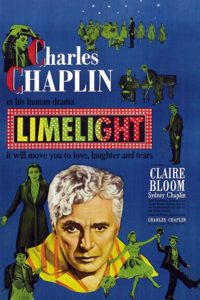“Life is a desire, not a meaning.”
|

Synopsis:
In 1914 London, a washed-up, alcoholic clown (Charlie Chaplin) saves a despondent young ballerina (Claire Bloom) from killing herself, and she soon falls in love with him. As Bloom’s career begins to take off, Chaplin’s fails to resuscitate; meanwhile, Bloom insists she wants to marry Chaplin rather than accept the advances of a handsome young composer (Sydney Chaplin).
|
|
Genres, Themes, Actors, and Directors:
- Alcoholism and Drug Addiction
- Ballet
- Charlie Chaplin Films
- Claire Bloom Films
- Clowns
- Do-Gooders
- Has-Beens
- May-December Romance
- Suicide
Response to Peary’s Review:
Peary writes that this late-career Chaplin film about a once-famous clown named Calvero who “inspires [a suicidal ballerina] to take a more optimistic view of life” is hurt by the fact that Chaplin clearly “craves sympathy”: his “Calvero (Chaplin’s surrogate) is a martyr whose vast talents are ignored by producers and the public, and who doesn’t realize (as Bloom and we do) what an altruistic, selfless human being he is.” Peary adds that “Bloom is an appealing lead, gorgeous (what a smile), tender, talented”, and that “Chaplin does some impressive comedy stage routines”. However, this well-meaning film is flawed in numerous ways: by dated Freudian psychology (Bloom is convinced she can’t even walk, let alone dance, until Calvero becomes her savior merely through encouragement); an overly leisurely screenplay that runs about an hour too long; and a melodramatic ending hyper-focused on Calvero’s martyrdom. Buster Keaton arrives near the end to co-star with Calvero but isn’t given sufficient focus or due. It’s also not clear why audience members are suddenly so uproariously engaged by Calvero’s routines during a final revival (unlike during previous performences)– is this meant to indicate Calvero’s fantasy during his final moments?
Redeeming Qualities and Moments:
- Claire Bloom as Terry

- Charlie Chaplin as Calvero

- Atmospheric cinematography

Must See?
No, though of course Chaplin fans will want to check it out.
Links:
|
One thought on “Limelight (1952)”
First viewing – at the time of my post in ‘The ’40s-’50s in Film’ (fb), which follows. A once-must for Chaplin fans; others may be less inclined.
“Life can be wonderful if you’re not afraid of it.”
‘Limelight’ (1952) [blu-ray]: Surprisingly, I had not seen this until now… and found myself moved (overall) by it. Considered Chaplin’s most personal film, it was not shown in most US theaters because Chaplin fell victim to McCarthy’s “Are you now or have you ever been…?” (The film finally got a wide US release in 1972.) The DVD has a very informative extra re: the film’s genesis – and is especially satisfying in explaining how the worlds of vaudeville and ballet crossed in London theater. Chaplin plays a musical clown to Claire Bloom’s ballerina. (It was Bloom’s first film; she was 19.) Bloom has given up on life – and, in an interesting development, it is revealed that the ‘illness’ she has is psychological. Chaplin’s Calvero inspires her to embrace life. However, when she does… and then Calvero himself falls prey to depression, Bloom’s attempts at encouragement (and love) are not as effective. ‘Limelight’ features 3 very familiar faces in its supporting cast: Marjorie Bennett, Nigel Bruce and Norman Lloyd. It is also the only time Chaplin and Buster Keaton appeared in a film together. I’ve always much preferred Keaton’s comedy over Chaplin’s. I’ve often thought that Chaplin tries too hard and overdoes things. ‘Limelight’ overdoes things somewhat at times and is flawed in some respects. Nevertheless, I mostly found it touching and much of it compelling.